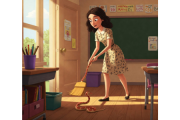With the help of the students, I moved the desks into small groups, to be considered tables in a café/restaurant. I put tablecloths on top of the clusters of desks. I made a large banner, with scalloped edges to represent the restaurant’s awning, with the name on it. I can’t remember what we called it now, “Chez Antoine”, or something similar. Some of the students took the role of customers, seated at tables, and others were waiters serving their customers. The waiters all had white tea towels tucked into their belts, to represent the long aprons worn by French servers. I acquired trays from somewhere (maybe from the school’s kitchen), and some cups, saucers, glasses and cutlery. The students contributed items, too. The café looked very good, I felt, when finished. The boys were enthusiastic. We had been learning all the vocabulary necessary for ordering meals, as well as how to summon a waiter, and what to do if you needed an item (mustard or sugar, for example) which had been overlooked. The boys had practiced what to say and to do. The scenario was complete!
I was thrilled with the result, and considered it to be worth the effort. The students enjoyed being in a café, ordering food, needing something extra to be brought to the table, paying the waiter, not forgetting his tip, of course. I loved it all and felt strongly that teaching in this way, with the students so involved, was much better than reading a story about people ordering food in a restaurant. The boys adopted their roles and spoke French to each other. It was great!
My practicum continued. I had so many ideas about how to teach in a lively way. I cut out pictures of animals onto the back of which I glued small Velcro strips, so that the animals could be stuck and unstuck onto a felt board which I had also made. Students could add and remove creatures, thus participating in scenarios as required. I might ask a question, in French, of course, such as which animals did you see when you were in the jungle? Which animals did you photograph on your safari? What did you see at the farm you visited? Which animals did you not see? The students would take turns naming the animals and putting the appropriate pictures on the felt board.
So I continued, making the lessons interactive. I used drama, did group work, drew all over the blackboard, employed props, and encouraged the students to come to the blackboard to draw, to compose, to be actively engaged in the learning process. Somehow, I knew that this was not only fun for the students, but also meant that they were more likely to stay interested, because of the way in which I was teaching. This was the beginning of a method of teaching that I was to pursue passionately for decades, no matter where I was living or working.
In 1970, as a student teacher, I assumed that I would remain in Rhodesia, since this was my home, where my parents and my brother Peter lived. I also knew that once I was fully qualified, I could be sent to any high school in the area to teach for two years. This was the contract that came with accepting the bursary I had been given by the government before I started university. I was scared that I might land up in an outlying area miles from Salisbury. I dreaded thinking about where this might be. I just hoped it wouldn’t be in the bush somewhere. I didn’t want to live again in a largely Afrikaans-speaking farming community, as I had done as a child in Darwendale, all those years previously.
Better to worry about that later on, I decided. For the moment, I needed to concentrate on getting through this last academic year, with its practicum teaching positions and its final examinations in December. The rest could wait.





